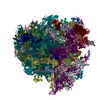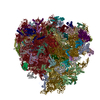+Search query
-Structure paper
| Title | Structural mechanism of angiogenin activation by the ribosome. |
|---|---|
| Journal, issue, pages | Nature, Vol. 630, Issue 8017, Page 769-776, Year 2024 |
| Publish date | May 8, 2024 |
 Authors Authors | Anna B Loveland / Cha San Koh / Robin Ganesan / Allan Jacobson / Andrei A Korostelev /  |
| PubMed Abstract | Angiogenin, an RNase-A-family protein, promotes angiogenesis and has been implicated in cancer, neurodegenerative diseases and epigenetic inheritance. After activation during cellular stress, ...Angiogenin, an RNase-A-family protein, promotes angiogenesis and has been implicated in cancer, neurodegenerative diseases and epigenetic inheritance. After activation during cellular stress, angiogenin cleaves tRNAs at the anticodon loop, resulting in translation repression. However, the catalytic activity of isolated angiogenin is very low, and the mechanisms of the enzyme activation and tRNA specificity have remained a puzzle. Here we identify these mechanisms using biochemical assays and cryogenic electron microscopy (cryo-EM). Our study reveals that the cytosolic ribosome is the activator of angiogenin. A cryo-EM structure features angiogenin bound in the A site of the 80S ribosome. The C-terminal tail of angiogenin is rearranged by interactions with the ribosome to activate the RNase catalytic centre, making the enzyme several orders of magnitude more efficient in tRNA cleavage. Additional 80S-angiogenin structures capture how tRNA substrate is directed by the ribosome into angiogenin's active site, demonstrating that the ribosome acts as the specificity factor. Our findings therefore suggest that angiogenin is activated by ribosomes with a vacant A site, the abundance of which increases during cellular stress. These results may facilitate the development of therapeutics to treat cancer and neurodegenerative diseases. |
 External links External links |  Nature / Nature /  PubMed:38718836 PubMed:38718836 |
| Methods | EM (single particle) |
| Resolution | 2.8 - 3.9 Å |
| Structure data |  EMDB-44457: 80S ribosome with angiogenin and ternary complex in rabbit reticulocyte lysates  EMDB-44458: 80S ribosome with angiogenin, in vitro assembled complex without substrate tRNA  EMDB-44459: 80S ribosome with H13A angiogenin  EMDB-44460: 80S ribosome with H13A angiogenin and tRNA EMDB-44461, PDB-9bdl: EMDB-44463, PDB-9bdn: EMDB-44464, PDB-9bdp: |
| Source |
|
 Keywords Keywords | RIBOSOME / Angiogenin / RNase |
 Movie
Movie Controller
Controller Structure viewers
Structure viewers About Yorodumi Papers
About Yorodumi Papers










 homo sapiens (human)
homo sapiens (human)

